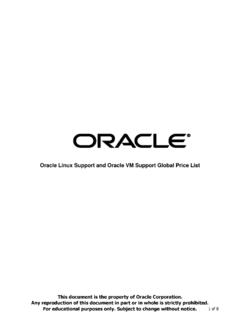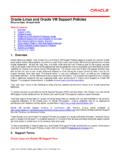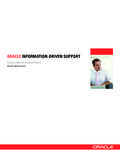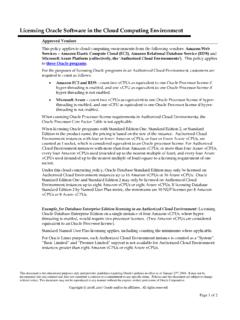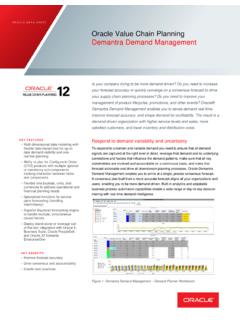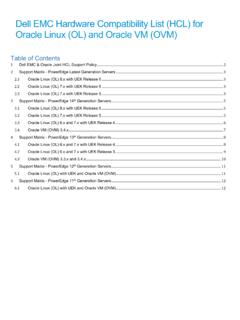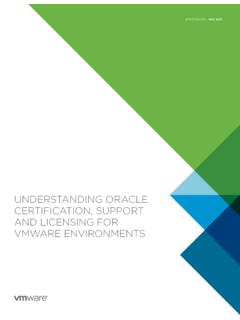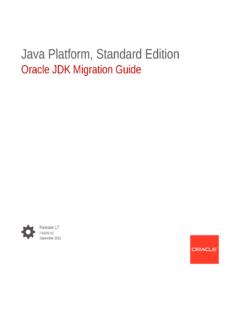Transcription of Migrate Virtual Machines from VMware to Oracle VM
1 Oracle VM 3: Migrate Virtual Machines from VMware to Oracle VM O R A C L E T E C H N I C A L W H I T E P A P E R | F E B R U A R Y 2 0 1 8 2 | Oracle VM 3: Migrate Virtual Machines FROM VMware TO Oracle VM Introduction 3 Solution 1: Migration using Open Virtualization Format 4 Example: step-by-step migration from VMware to Oracle VM with OVA 4 Solution 2: Migration using data replication 10 Example: step-by-step migration of an Application using data replication 11 Example: step-by-step migration of an Oracle Database using data replication 16 Solution 3: Conversion using open-source utilities 22 Example: step-by-step migration using open-source utilities 22 Solution 4: Automated migration using CLI interfaces 28 Automation Requirements 30 Initialization file 31 Steps executed by the script 33 Script execution: output example 35 Debug Execution script.
2 38 APPENDIX A Consideration while migrating 39 Linux platform migration 39 Microsoft Windows platform migration 39 Conclusion 40 3 | Oracle VM 3: Migrate Virtual Machines FROM VMware TO Oracle VM Introduction This paper explains the best practices to help Migrate Virtual Machines from VMware to Oracle VM. The paper outlines different approaches with pros and cons, and multiple options can be used to accomplish the migration goal. The Oracle VM virtualization solution is engineered for open cloud infrastructure. It delivers leading performance, scalability and reliability for enterprise SaaS and PaaS workloads as well as traditional enterprise applications. Oracle VM support offers access to award-winning Oracle support resources and virtualization support specialists, zero-downtime updates using Ksplice, additional management tools such as Oracle Enterprise Manager, and lifetime support , all at a low cost.
3 Oracle VM is easy to download, completely free to use, and free to distribute. Oracle VM features rapid application deployment, integrated lifecycle management, and active participation in industry trends, thus offers customers more choices by not only delivering standalone x86 virtualization solution, but also fully integrated converged infrastructure such as Oracle Private Cloud Appliance (PCA) and many other Oracle Engineered Systems as well as joint partner offerings as means to on-board traditional datacenters to the cloud. Figure 1: Migration from VMware to Oracle VM As you can see from the picture above, the most common approach to Migrate Virtual Machines is based on Open Virtualization Format (OVF) which is an open standard for packaging and distributing Virtual appliances or, more generally, software to be run in Virtual Machines . The OVF standard is not tied to any particular hypervisor and provides an open, efficient and extensible format for the packaging and distribution of Virtual Machines .
4 With any migration between different technologies, a service outage will need to be factored into the migration; so, it becomes fundamental to identify the correct balance between ease of migration and time of disruption. A point that reflects on both ease of migration and time of disruption is the size of the Virtual machine , in terms of disk space used/allocated. Once the time of disruption (service outage) requirement has been identified, choosing the migration method will be possible based on the Virtual machine size. In this white paper, each chapter describes a step-by-step approach on how-to Migrate from VMware to Oracle VM and, at the same time, supplies a brief pros/cons table of the method used. 4 | Oracle VM 3: Migrate Virtual Machines FROM VMware TO Oracle VM Solution 1: Migration using Open Virtualization Format Virtual appliances are packages created as a single.
5 Ova (Open Virtualization Format Archive) file or a set of .ovf (Open Virutalization Format) and .img (disk image) files. Virtual appliances can contain one or more Virtual Machines and include the Virtual disks and the inter-connectivity between the Virtual Machines . To get started with Virtual machine conversion, you can always export VMware Virtual machine into an OVF based Virtual appliance and, after that, import the Virtual appliance using Oracle VM Manager web interface. ProsCons Easiest solution possible Service outage depends of Virtual machine size; bigger is the size of Virtual -disks higher is the outage time. Applicable also to all main x86 hypervisor solutions OS/Application maintenance cannot be executed simultaneously. Based on an open and standard format (OVF) Old Operating System could need a particular tweak on the source Virtual machine before exporting it.
6 Applicable to all x86 Virtual - machine Operating System Example: step-by-step migration from VMware to Oracle VM with OVA Here the general steps needed to export a VM from VMware and consequently import to Oracle VM using OVA format: 1. Stop the Virtual machine on VMware ESXi 2. Export VM into OVF Format a. select the VM, File, Export, Export OVF b. Select .ova file 5 | Oracle VM 3: Migrate Virtual Machines FROM VMware TO Oracle VM Figure 2: Export the VM into OVA format 3. Import the .ova file to Oracle VM/PCA as a new Assembly / Appliance Figure 3: Oracle VM Manager: Import Virtual Appliance 4. Create an Oracle VM Virtual machine directly from the Virtual Appliance imported. Note This option is available starting from Oracle VM Release; on previous Oracle VM Releases (as or ) it s still needed to initially create an Oracle VM Template from the Virtual Appliance (OVA imported) and then create the Virtual machine from the Template.
7 6 | Oracle VM 3: Migrate Virtual Machines FROM VMware TO Oracle VM Figure 4: Oracle VM Manager: Create Virtual machine from Virtual Appliance (OVA) 6. Edit the Virtual machine created and, optionally, customize it. A. Configuration: choose VM Name, Operating System running, Keymap for console, Domain Type, Start Policy, Memory options and CPUs options. Figure 5: Oracle VM Manager: Edit Virtual machine Settings (Configuration) 7 | Oracle VM 3: Migrate Virtual Machines FROM VMware TO Oracle VM Note To get further details related to the Virtual machine Domain Type option refers to the Oracle VM Documentation at the following link: Note For systems running Red Hat Enterprise Linux, CentOS or Oracle Linux, it s always suggested to install and use UEK kernel on the VM; UEK is capable to work as HVM, PVM and HVM with PV Drivers. B.
8 Networks: choose vNICs needed and associate them to the VM; if needed you can also specify a custom MAC Address to the vNIC (could be the MAC used on the source VM, helpful while an application license is based on NIC HWADDR) Figure 6: Oracle VM Manager: Edit Virtual machine Settings (Networks) Note The option Specify MAC Address can be helpful also while the HWADDR is specified into the Operating System Network configuration files (as ifcfg-eth0 on a Linux system or, as default, on Microsoft Windows OS); alternatively it s suggested to leave out the HWADDR entry of the NIC into the configuration file on the Virtual machine operating system. 8 | Oracle VM 3: Migrate Virtual Machines FROM VMware TO Oracle VM C. Disks: evaluate to add and/or modify existing Virtual /physical disks to the Virtual machine . Figure 7: Oracle VM Manager: Edit Virtual machine Settings (Disks) D.
9 Boot Order: evaluate to change the boot-order for the Virtual machine Figure 8: Oracle VM Manager: Edit Virtual machine Settings (Boot Order) E. Tags: evaluate optional tags, helpful while looking for VMs into a huge list 9 | Oracle VM 3: Migrate Virtual Machines FROM VMware TO Oracle VM 7. Start the VM Figure 9: Oracle VM Manager: Start Virtual machine 8. Uninstall VMware tools from the Virtual machine 9. On Microsoft Windows Virtual machine install Oracle VM Paravirtualized Drivers for Microsoft Windows. Note Using Oracle VM Manager it s also possible to import raw-image disk images (img); the import process, automatically, will associate one UUID to the Virtual disk imported. Known Issues and possible work-around / solutions: My Oracle support Blue Screen on Boot after Migrating VMware Windows Guest Which is Installed on SCSI Disk to Oracle VM (V2V) (Doc ID ) Oracle VM : Import of VMware Oracle Linux 6 Guest conversion from HVM to PVHVM (Doc ID ) Oracle VM: Unable to load X Server inside a Guest VM (Doc ID ) 10 | Oracle VM 3: Migrate Virtual Machines FROM VMware TO Oracle VM Solution 2: Migration using data replication A possible migration from one system, Virtual or physical, to a new one could also introduce the opportunity to execute software maintenance while migrating.
10 So, while the software layer is upgraded in place on the target system by installing updated OS, Application or Database release, the data will be replicated using Operating System utilities like rsync or other storage replication options, both software (like ASM) or hardware (low-level storage replication). rsync is a fast and extraordinarily versatile file copying tool. It can copy locally, to/from another host over any remote shell, or to/from a remote rsync daemon. It offers a large number of options that control every aspect of its behavior and permit very flexible specification of the set of files to be copied. It is famous for its delta-transfer algorithm, which reduces the amount of data sent over the network by sending only the differences between the source files and the existing files in the destination. Rsync is widely used for backups and mirroring and as an improved copy command for everyday use.
